Long-Term Corrosion Testing of Zy-4 in a LiOH Solution under High Pressure and Temperature Conditions
Abstract
:1. Introduction
2. Materials and Methods
2.1. Materials
2.2. Morphological and Structural Surface Analysis
2.3. Electrochemical Tests
3. Results and Discussion
3.1. Oxidation Kinetics
3.2. Morphological and Structural Characterization
3.2.1. Metallographic Analysis (Optical Microscopy)
3.2.2. Scanning Electron Microscopy (SEM) Measurements
3.2.3. XPS Measurements
3.3. Electrochemichal Characterization
3.3.1. Electrochemical Impedance Spectroscopy
3.3.2. Potentiodynamic Polarization Tests
3.3.3. Open Circuit Potential Measurements
4. Conclusions
Author Contributions
Funding
Institutional Review Board Statement
Informed Consent Statement
Data Availability Statement
Acknowledgments
Conflicts of Interest
References
- Hosemann, P.; Frazer, D.; Fratoni, M.; Bolind, A.; Ashby, M.F. Materials selection for nuclear applications: Challenges and opportunities. Scr. Mater. 2018, 143, 181–187. [Google Scholar] [CrossRef] [Green Version]
- Sidelev, D.V.; Syrtanov, M.S.; Ruchkin, S.E.; Pirozhkov, A.V.; Kashkarov, E.B. Protection of Zr Alloy under High-Temperature Air Oxidation: A Multilayer Coating Approach. Coatings 2021, 11, 227. [Google Scholar] [CrossRef]
- Tudose, A.E.; Demetrescu, I.; Golgovici, F.; Fulger, M. Oxidation Behavior of an Austenitic Steel (Fe, Cr and Ni), the 310 H, in a Deaerated Supercritical Water Static System. Metals 2021, 11, 571. [Google Scholar] [CrossRef]
- Fulger, M.; Lucan, D.; Mihalache, M.; Velciu, L. Factors Involved in Stress Corrosion Cracking of Tubes from a Nuclear Power Plant Feedwater Heater. Rev. Chim. 2019, 70, 3926–3930. [Google Scholar] [CrossRef]
- Gajowiec, G.; Bartmanski, M.; Majkowska-Marzec, B.; Zielinski, A.; Chmiela, B.; Derezulko, M. Hydrogen Embrittlement and Oxide Layer Effect in the Cathodically Charged Zircaloy-2. Materials 2020, 13, 1913. [Google Scholar] [CrossRef] [Green Version]
- Zhao, H.; Yang, C.; Guo, D.; Wu, L.; Mao, J.; Pan, R.; Qin, J.; Shi, B. Coupled Thermomechanical Responses of Zirconium Alloy System Claddings under Neutron Irradiation. Appl. Sci. 2021, 11, 1308. [Google Scholar] [CrossRef]
- Adamson, R.B.; Rudling, P. Properties of Zirconium Alloys and Their Applications in Light Water Reactors (LWRs) in Materials Ageing and Degradation in Light Water Reactors; Woodhead Publishing: Cambridge, UK, 2013; pp. 151–245. [Google Scholar] [CrossRef]
- Takiishi, H.; Duvaizen, J.H.; Sato, I.M.; Rossi, J.L.; Pereira, L.A.T.; Martinez, L.G. Recycling of Zircaloy machining chips by VAR remelting and powder metallurgy techniques. Mater. Sci. Forum 2012, 727, 356–361. [Google Scholar] [CrossRef]
- Steinbrück., M. Hydrogen absorption by zirconium alloys at high temperatures. J. Nucl. Mater. 2004, 334, 58–64. [Google Scholar] [CrossRef]
- Steinbrück, M.; Böttcher, M. Air oxidation of Zircaloy-4, M5 (R) and ZIRLO (TM ) cladding alloys at high temperatures. J. Nucl. Mater. 2011, 414, 276–285. [Google Scholar] [CrossRef]
- Wadekar, S.; Raman, V.; Banerjee, S.; Asundi, M. Structure-property correlation of Zr-base alloys. J. Nucl. Mater. 1988, 151, 162–171. [Google Scholar] [CrossRef]
- Pêcheur, D. Oxidation of β-Nb and Zr (Fe,V)2 precipitates in oxide films formed on advanced Zr-based alloys. J. Nucl. Mater. 2000, 278, 195–201. [Google Scholar] [CrossRef]
- Wei, J.; Frankel, P.; Polatidis, E.; Blat, M.; Ambard, A.; Comstock, R.; Hallstadius, L.; Hudson, D.; Smith, G.; Grovenor, C. The effect of Sn on autoclave corrosion performance and corrosion mechanisms in Zr-Sn-Nb alloys. Acta Mater. 2013, 61, 4200–4214. [Google Scholar] [CrossRef]
- Zhou, B.X.; Yao, M.Y.; Li, Z.K.; Wang, X.M.; Zhou, J.; Long, C.S.; Liu, Q.; Luan, B.F. Optimization of N18 zirconium alloy for fuel cladding of water reactors. J. Mater. Sci. Technol. 2012, 28, 606–613. [Google Scholar] [CrossRef]
- Liu, W.; Li, Q.; Zhou, B.; Yan, Q.; Yao, M. Effect of heat treatment on the microstructure and corrosion resistance of a Zr-Sn-Nb-Fe-Cr alloy. J. Nucl. Mater. 2005, 341, 97–102. [Google Scholar] [CrossRef]
- Zhang, R.; Jiang, B.; Pang, C.; Dai, X.; Sun, Y.; Liao, W.; Wang, Q.; Dong, C. New Low-Sn Zr Cladding Alloys with Excellent Autoclave Corrosion Resistance and High Strength. Metals 2017, 7, 144. [Google Scholar] [CrossRef] [Green Version]
- Tupin, M.; Martin, F.; Bisor, C.; Verlet, R.; Bossis, P.; Chene, J.; Jomard, F.; Berger, P.; Pascal, S.; Nuns, N. Hydrogen diffusion process in the oxides formed on Zirconium alloys during corrosion in Pressurized Water Reactor Conditions. Corros. Sci. 2016, 116, 1–13. [Google Scholar] [CrossRef] [Green Version]
- Garner, G.L.; Hilton, B.A.; Mader, E. Performance of alloy M5TM cladding and structure. In Proceedings of the LWR Fuel Performance Meeting/Top Fuel, San Francisco, CA, USA, 30 September–3 October 2007. [Google Scholar]
- Bell, B.D.C.; Murphy, S.T.; Burr, P.A.; Comstock, R.J.; Partezana, J.M.; Grimes, R.W.; Wenman, M.R. The influence of alloying elements on the corrosion of Zr alloys. Corros. Sci. 2016, 105, 36–43. [Google Scholar] [CrossRef] [Green Version]
- Bossis, P.; Verhaeghe, B.; Doriot, S.; Gilbon, D.; Chabretou, V.; Dalmais, A.; Mardon, J.-P.; Blat, M.; Miquet, A. In PWR Comprehensive Study of High Burn-Up Corrosion and Growth Behavior of M5 and Recrystallized Low-Tin Zircaloy-4. In Zirconium in the Nuclear Industry: 15th International Symposium; ASTM International: West Conshohocken, PA, USA, 2008; pp. 430–456. [Google Scholar]
- Tupin, M.; Hamann, J.; Cuisinier, D.; Bossis, P.; Blat, M.; Ambard, A.; Miquet, A.; Kaczorowski, D. Understanding of corrosion mechanisms of zirconium alloys after irradiation: Effect of ion irradiation of the oxide layers on the corrosion rate, in Zirconium. In the Nuclear Industry, 17th International Symposium; ASTM International: West Conshohocken, PA, USA, 2014; pp. 438–478. [Google Scholar]
- RRobson, J.D. Modelling precipitate amorphization in Zircaloys. J. Nucl. Mater. 2021, 551, 152944. [Google Scholar] [CrossRef]
- Wang, P.; Was, G.S. Oxidation of Zircaloy-4 during in situ proton irradiation and corrosion in PWR primary water. J. Mater. Res. 2015, 30, 1335–1348. [Google Scholar] [CrossRef]
- Blat, M.; Legras, L.; Noel, D.; Amanrich, H. Contribution to a Better Understanding of the Detrimental Role of Hydrogen on the Corrosion Rate of Zircaloy-4 Cladding Materials. In Zirconium in the Nuclear Industry: Twelfth International Symposium; ASTM International: West Conshohocken, PA, USA, 2000; pp. 563–591. [Google Scholar]
- Pirvan, I.; Radulescu, M.; Lucan, D.; Visan, T. The influence some anions and the oxygen dissolved in the medium have upon Zircaloy-4 and Zr-2. 5% Nb alloys oxidation and hydration, Rev. Chim. 1998, 49, 713–719. [Google Scholar]
- Was, G.S.; Petti, D.; Ukai, S.; Zinkle, S. Materials for future nuclear energy systems. J. Nucl. Mater. 2019, 527, 151837. [Google Scholar] [CrossRef]
- Morcillo, M.; Chico, B.; Díaz, I.; Cano, H.; de la Fuente, D. Atmospheric corrosion data of weathering steels. A review. Corros. Sci. 2013, 77, 6–24. [Google Scholar] [CrossRef] [Green Version]
- Bella, B.D.C.; Murphy, S.T.; Burra, P.A.; Grimesa, R.W.; Wenman, M.R. Accommodation of Tin in Tetragonal ZrO2. J. Appl. Phys. 2015, 117, 08490. [Google Scholar] [CrossRef] [Green Version]
- Wang, Z.; Li, H.; Xu, L.; Liu, Q.; Zha, L.; Lin, S. Electrochemical Corrosion Study of Zircaloy-4 in a LiOH Solution at High Temperature and Pressure. Int. J. Electrochem. Sci. 2018, 13, 12163–12171. [Google Scholar] [CrossRef]
- Hudson, D.; Ni, N.; Lozano-Perez, S.; D. Saxey, D. The atomic scale structure and chemistry of the Zircaloy-4 metal–oxide interface. In Proceedings of the 14th International Conference on Environmental Degradation of Materials in Nuclear Power Systems Water Reactors, Virginia Beach, VI, USA, 23–27 August 2009. [Google Scholar]
- Shibata, A.; Kato, Y.; Taguchi, T.; Futakawa, M.; Maekawa, K. Corrosion Properties of Zircaloy-4 and M5 under Simulated PWR Water Conditions. Nucl. Technol. 2016, 196, 89–99. [Google Scholar] [CrossRef]
- Allen, T.R.; Konings, R.J.M.; Motta, A.T. Corrosion of Zirconium Alloys. In Comprehensive Nuclear Materials; Elsevier: Amsterdam, The Netherlands, 2012; Volume 5, pp. 49–68. [Google Scholar]
- Motta, A.T. Waterside corrosion in zirconium alloys. J. Miner. Met. Mater. Soc. 2011, 63, 59–63. [Google Scholar] [CrossRef]
- Yagnik, S.; Garde, A. Zirconium Alloys for LWR Fuel Cladding and Core Internals. In Structural Alloys for Nuclear Energy Applications; Elsevier: Amsterdam, The Netherlands, 2019. [Google Scholar]
- Yu, Q.; Reyes, M.; Shah, N.; Marian, J. Kinetic Model of Incipient Hydride Formation in Zr Clad Under Dynamic Oxide Growth Conditions. Materials 2020, 13, 1088. [Google Scholar] [CrossRef] [Green Version]
- Lucan, D. Behaviour of the Steam Generator Tubing in Water with Different pH Values. Nucl. Eng. Des. 2011, 241, 1172–1176. [Google Scholar] [CrossRef]
- Portier, L.; Bredel, T.; Brachet, J.C.; Maillot, V.; Jean-Paul, M.; Lesbros, A. Influence of Long Service Exposures on the Thermal-Mechanical Behavior of Zy-4 and M5 (TM ) Alloys in LOCA Conditions. J. ASTM Int. 2005, 2, 2468. [Google Scholar] [CrossRef]
- Nishino, Y.; Krauss, A.R.; Lin, Y.; Gruen, D.M. Initial oxidation of zirconium and Zircaloy-2 with oxygen and water vapor at room temperature. J. Nucl. Mater. 1996, 228, 346–353. [Google Scholar] [CrossRef]
- Bespalov, I.; Datler, M.; Buhr, S.; Drachsel, W.; Rupprechter, G.; Suchorski, Y. Initial stages of oxide formation on the Zr surface at low oxygen pressure: An in situ FIM and XPS study. Ultramicroscopy 2015, 159, 147–151. [Google Scholar] [CrossRef] [PubMed] [Green Version]
- Naumkin, A.V.; Kraut-Vass, A.; Gaarenstroom, S.W.; Powell, C.J. NIST X-ray Photoelectron Spectroscopy Database NIST Standard Reference Database 20, version 4.1; National Institute of Standards and Technology: Gaithersburg, MA, USA, 2012. [Google Scholar]
- Morant, C.; Sanz, J.M.; Galán, L.; Soriano, L.; Rueda, F. An XPS study of the interaction of oxygen with zirconium. Surf. Sci. 1989, 218, 331–345. [Google Scholar] [CrossRef]
- Kaufmann, R.; Klewe-Nebenius, H.; Moers, H.; Pfennig, G.; Jenett, H.; Ache, H.J. XPS studies of the thermal behaviour of passivated Zircaloy-4 surfaces. Surf. Interface Anal. 1988, 11, 502–509. [Google Scholar] [CrossRef]
- West, P.E.; George, P.M.J. An x-ray photoelectron spectroscopy investigation of the incorporation of surface oxides into bulk zirconium. J. Vac. Sci. Technol. A. 1987, 5, 1124–1127. [Google Scholar] [CrossRef]
- De Gonzalez, C.; Garcia, E.A. An X-ray photoelectron spectroscopy study of the surface oxidation of zirconium. Surf. Sci. 1988, 193, 305–320. [Google Scholar] [CrossRef]
- Moulder, J.F.; Stickle, W.F.; Sobol, P.E.; Bomben, K.D. Handbook of X-ray Photoelectron Spectroscopy; ULVAC-PHI, Inc.: Chigasaki, Japan, 1995; pp. 253–8522. [Google Scholar]
- Platt, P.; Polatidis, E.; Frankel, P.; Klaus, M.; Gass, M.; Howells, R.; Preuss, M. A study into stress relaxation in oxides formed on zirconium alloys. J. Nucl. Mater. 2015, 456, 415–425. [Google Scholar] [CrossRef]
- Kim, S.; Kim, T.; Kim, J.H.; Bahn, C.B. Microscopic characterization of pretransition oxide formed on Zr–Nb–Sn alloy under various Zn and dissolved hydrogen concentrations. Nucl. Eng. Technol. 2018, 50, 416–424. [Google Scholar] [CrossRef]
- Lin, X.; Zhang, X.; Wu, L.; Yao, M.; Liang, X.; Peng, J.; Hu, L.; Xie, Y.; Zhou, B. Effect of Zr2+ irradiation on microstructure and corrosion behavior of 90Nb-10Zr binary alloy in 360 °C lithiated water. Corros. Sci. 2021, 189, 109620. [Google Scholar] [CrossRef]
- Schanz, G.; Leistikow, S. ZrO2 Scale Degradation during Zircaloy-4 High Temperature Steam Exposure. Microstructural Mechanism and Consequences for PWR Safety Analysis Proc. In Proceedings of the ANS/ENS Topical Meeting on Reactor Safety Aspects of Fuel Behaviour, Sun Valley, ID, USA, 2–6 August 1981; Volume II, pp. 342–353. [Google Scholar]
- Chung, H.M.; Thomas, G.K. High-Temperature Oxidation of zircaloy in Hydrogen—Steam Mixtures. In Proceedings of the Sixth International Conference on Zirconium in the Nuclear Industry, Vancouver, BC, Canada, 28 June–1 July 1982. [Google Scholar]
- Schanz, G.; Leistikow, S. Microstructural Reasons for Mechanical Oxide Degradation (Breakaway Effect) and Resulting Kinetic Anomalies of Zircaloy-4/Steam-HT-Oxidation. In Proceedings of the 8th International Congress Metallic Corrosion, Mainz, Germany, 6–11 September 1981; Volume II, pp. 1712–1717. [Google Scholar]
- Leistikow, S.; Schanz, G. Oxidation kinetics and related phenomena of Zircaloy-4 fuel cladding exposed to high temperature steam and hydrogen-steam mixtures under PWR accident conditions. Nucl. Eng. Des. 1987, 103, 65–84. [Google Scholar] [CrossRef]
- Steinbruck, M.; Birchley, J.; Goryachev, A.V.; Grosse, M.; Haste, T.J.; Hozer, Z.; Kisselev, A.E.; Nalivaev, V.I.; Semishkin, V.P.; Sepold, L.; et al. Status of studies on high temperature oxidation and quench behavior of Zircaloy-4 and E110 cladding alloys. In Proceedings of the 3rd European Review Meeting on Severe Accident Research, Nesseber, Bulgaria, 23–25 September 2008. [Google Scholar]
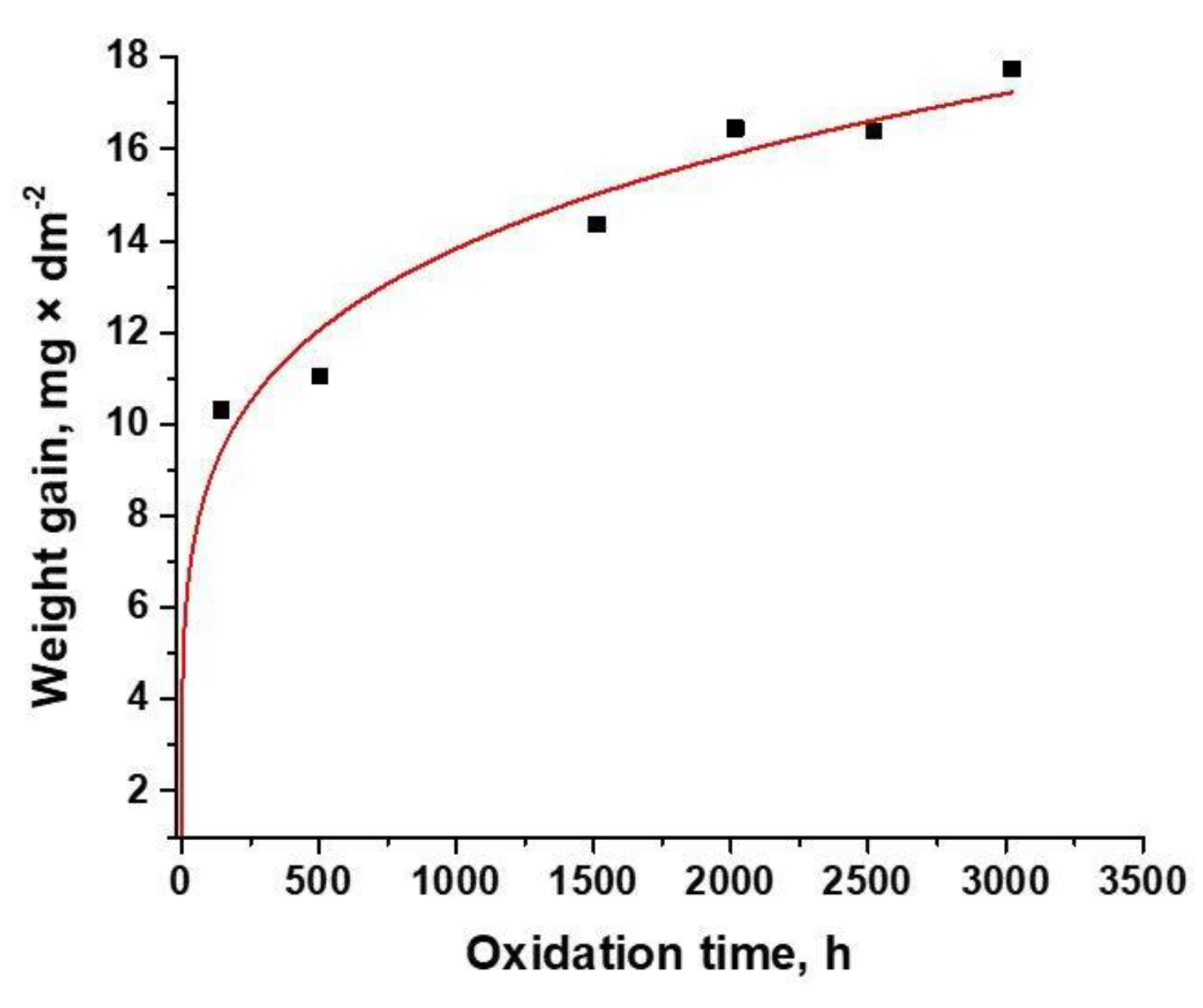
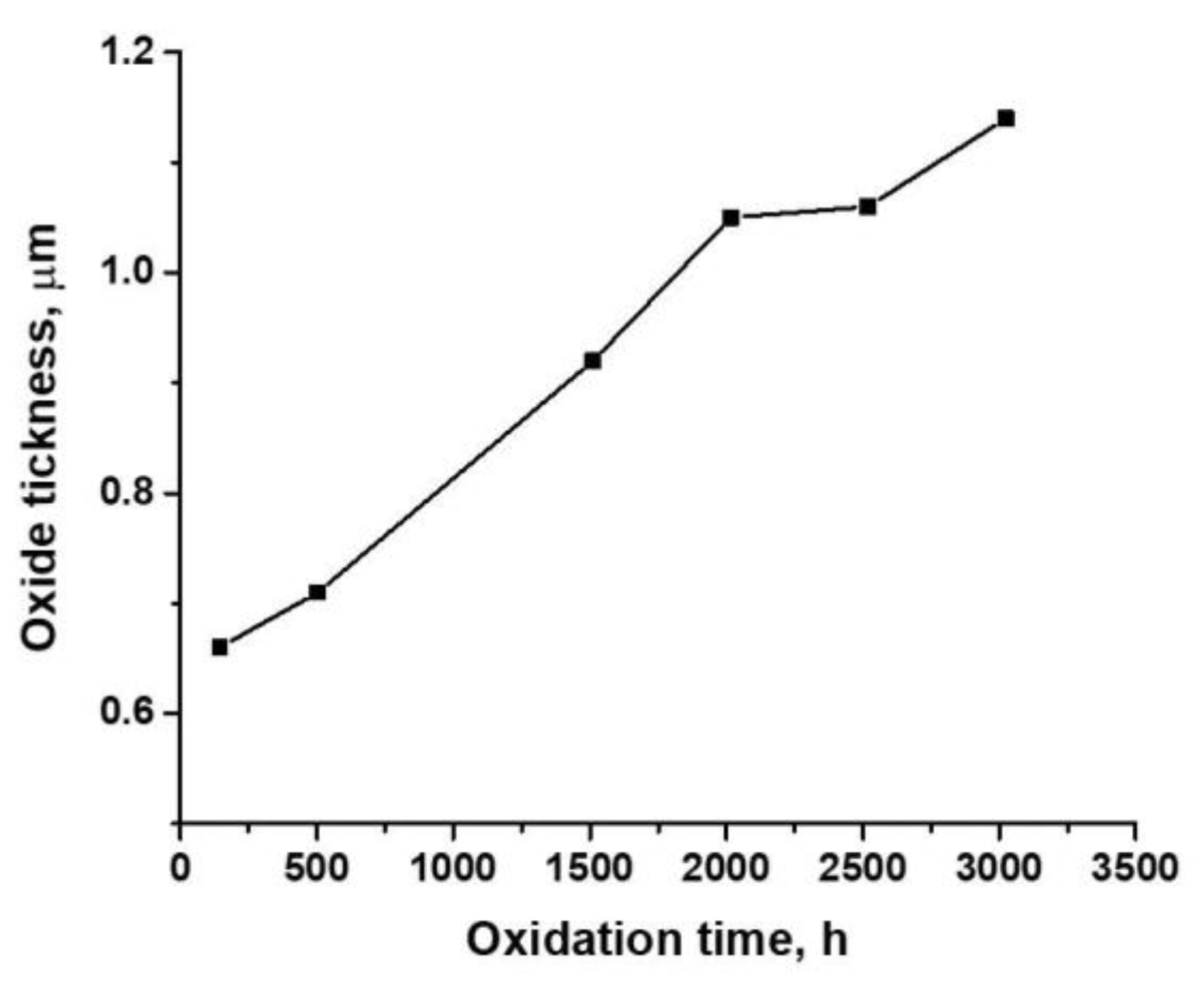
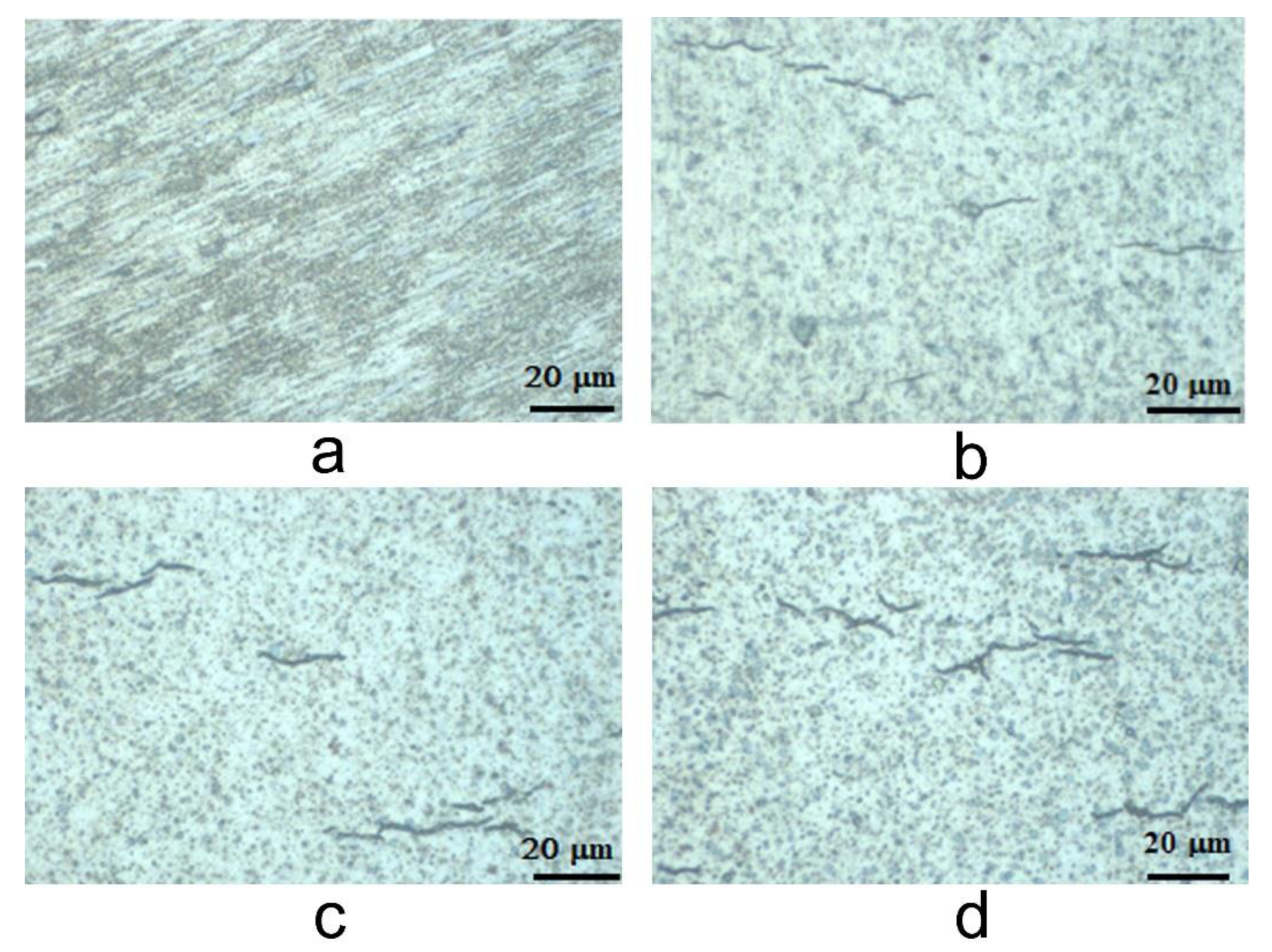
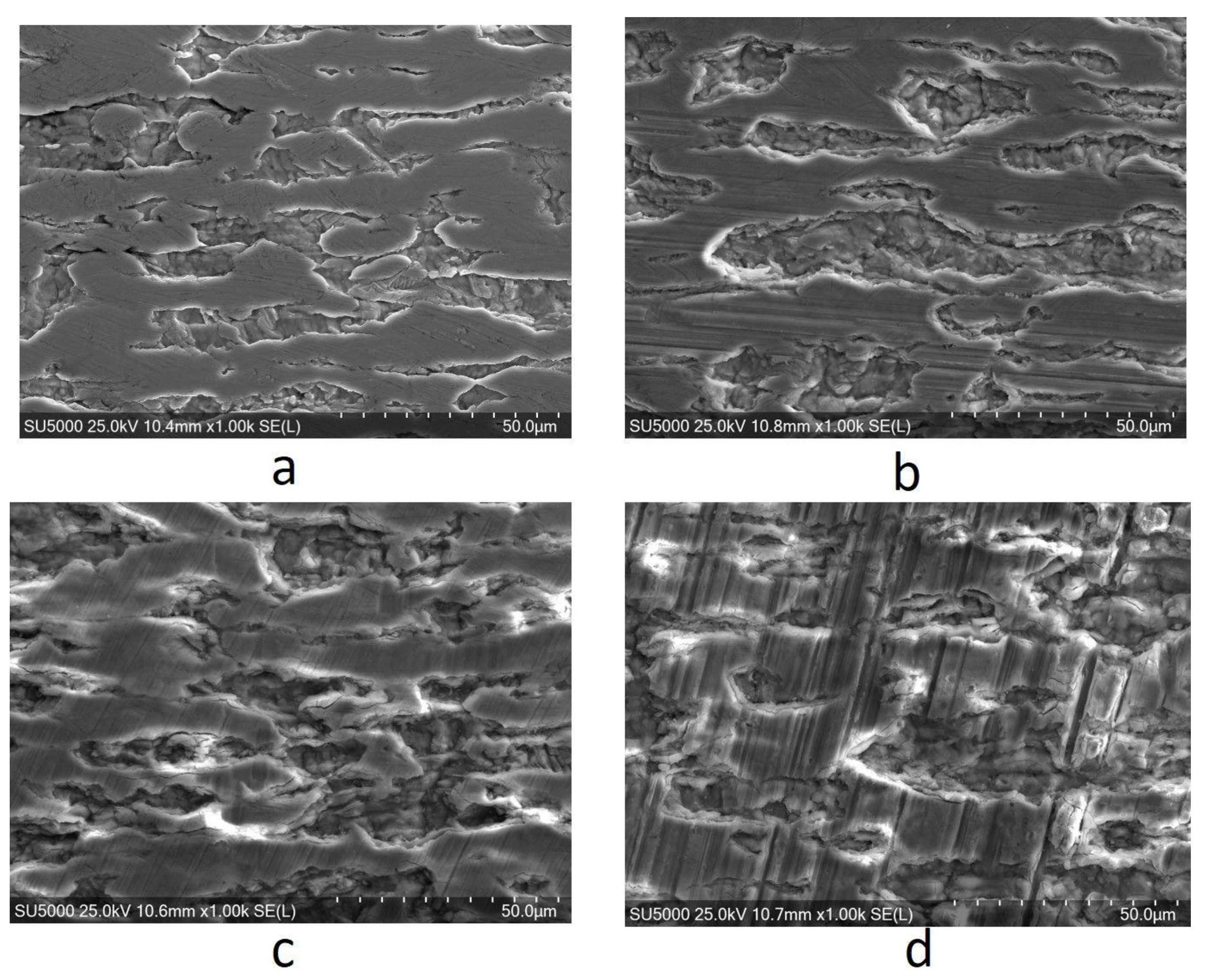
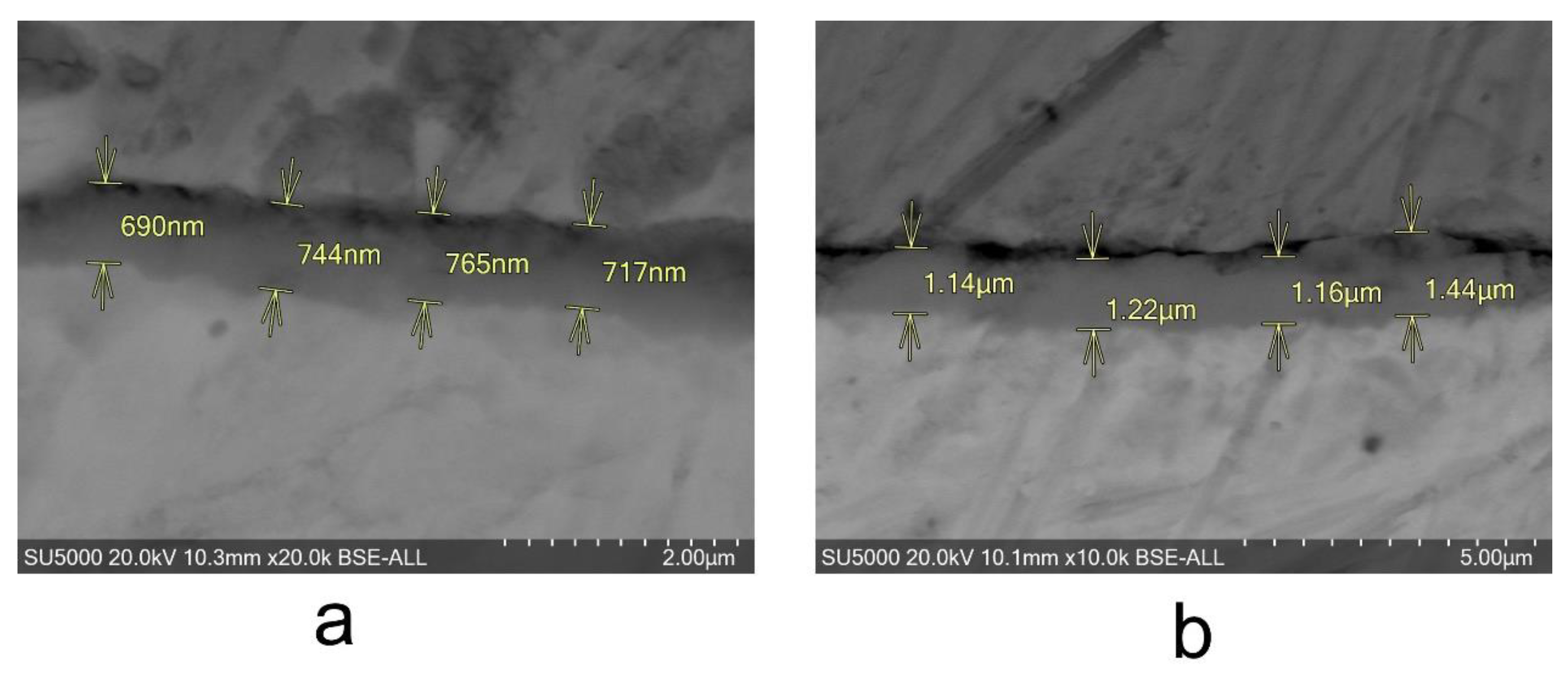
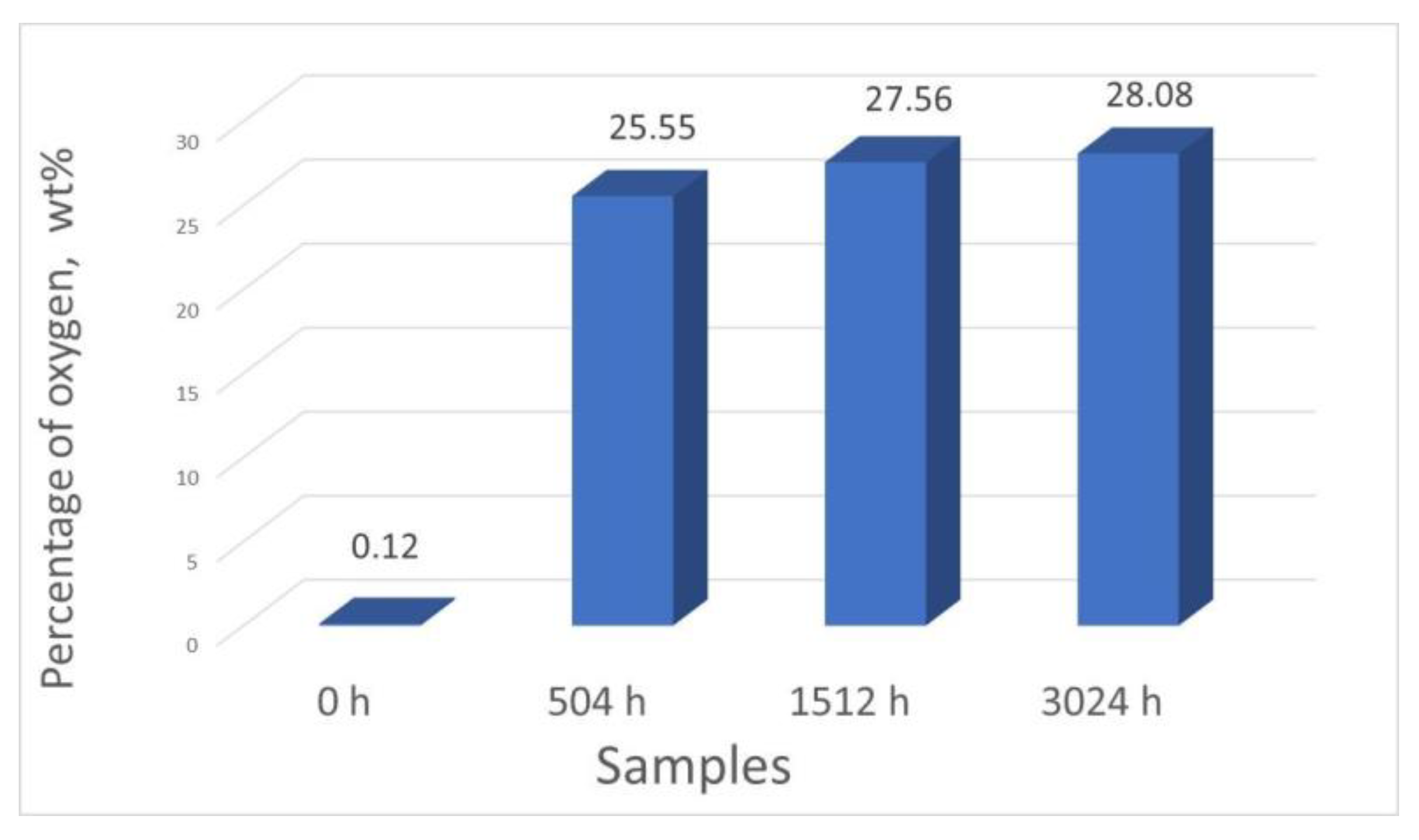

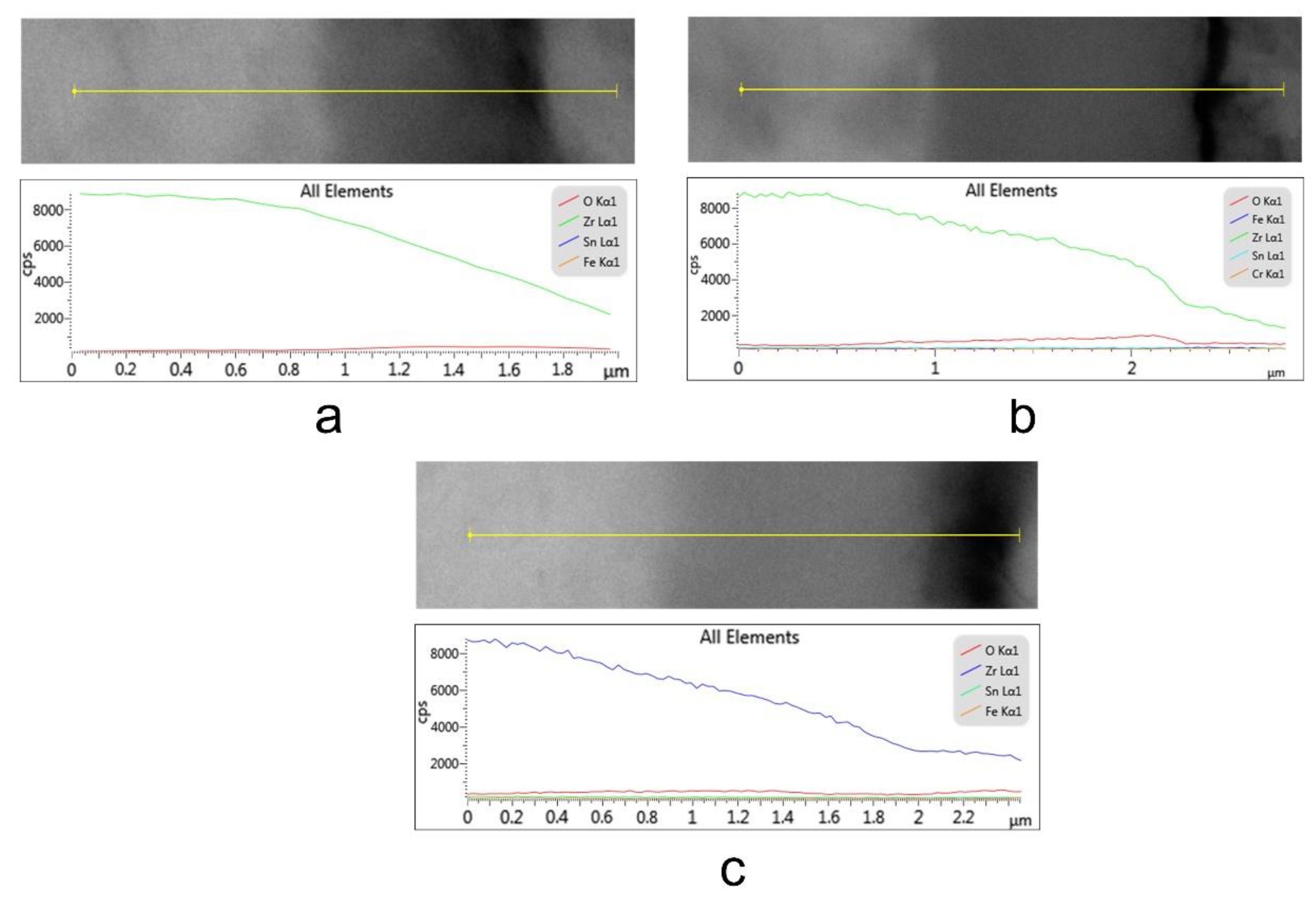

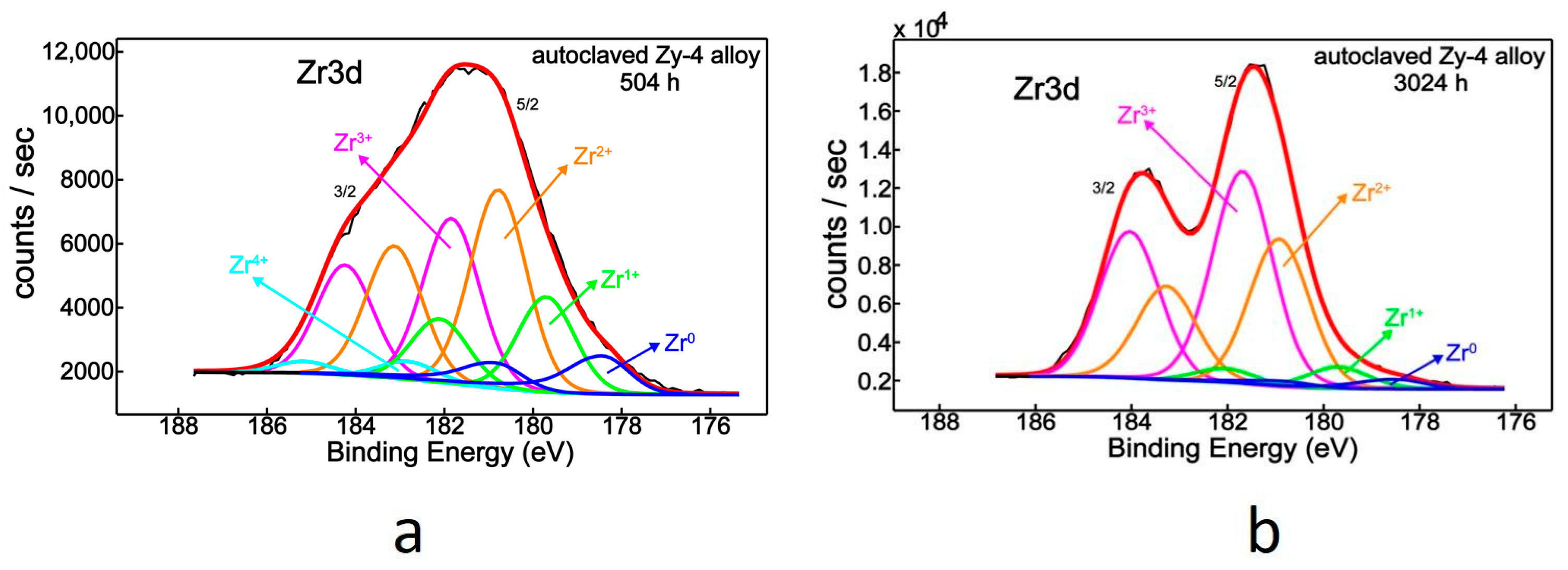
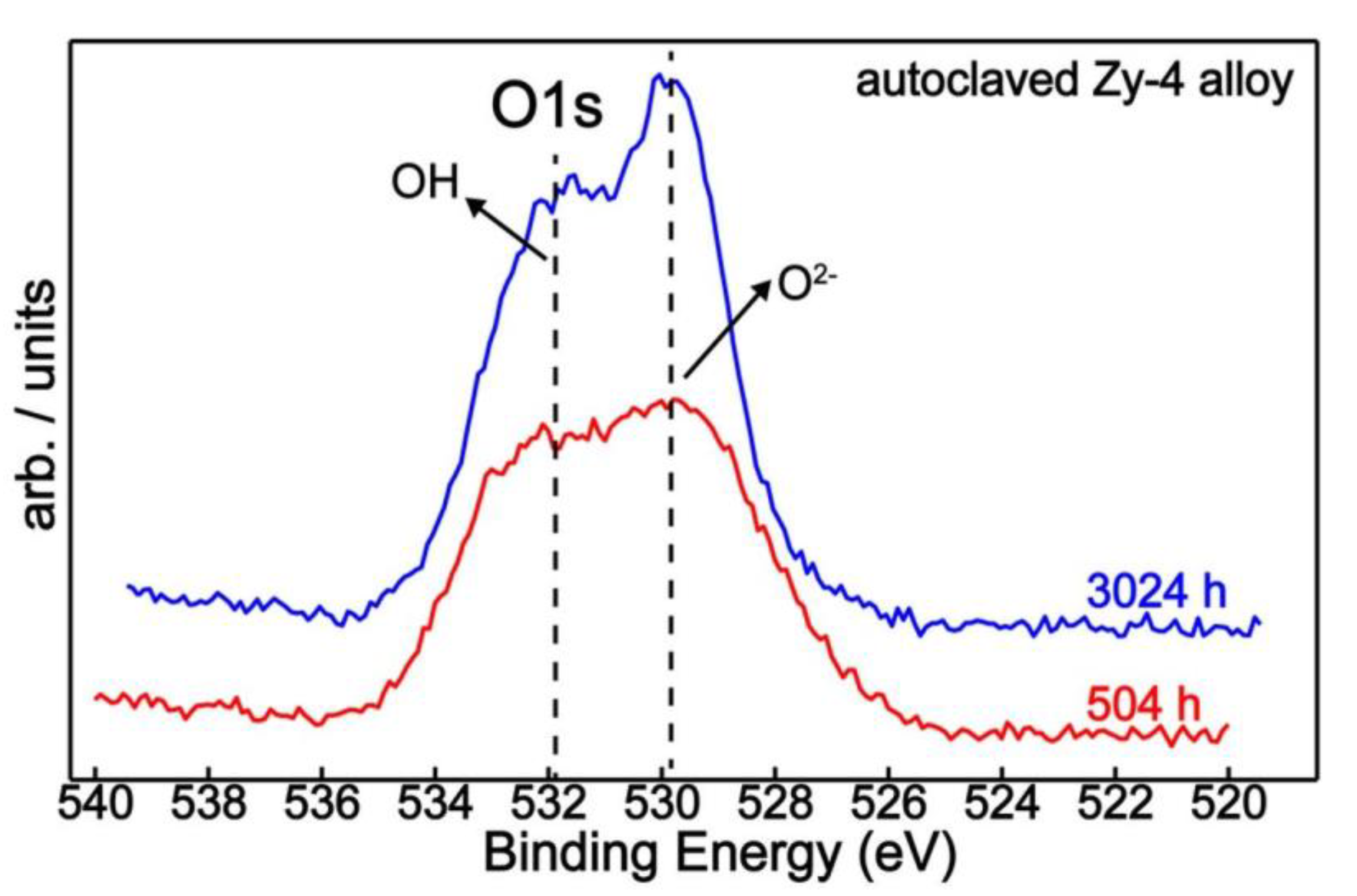



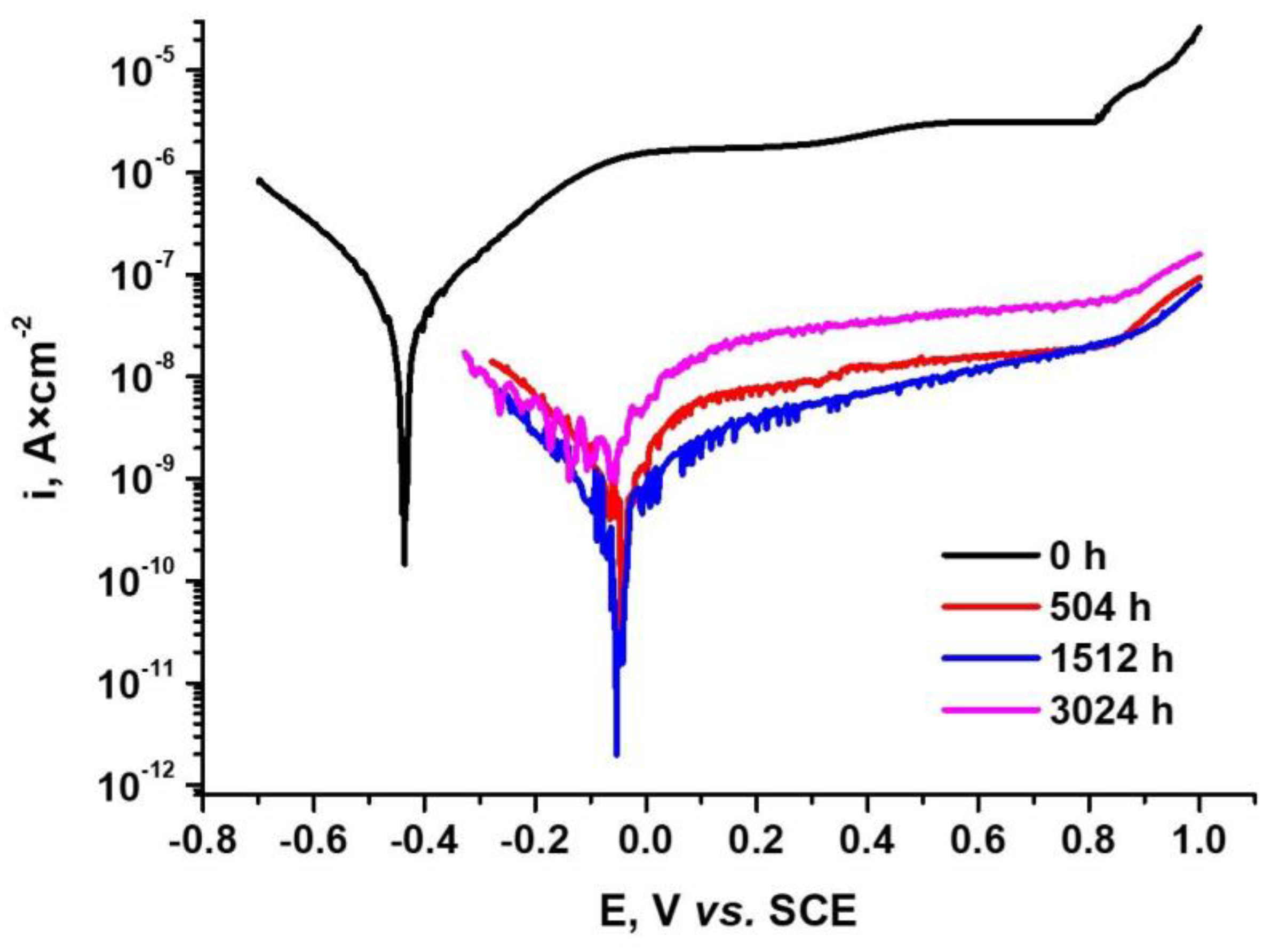

| Alloying Elements, [wt.%] | ||||
|---|---|---|---|---|
| Sn | Fe | Cr | O | Zr |
| 1.32 | 0.29 | 0.14 | 0.12 | Balance |
| Kinetic Equation | kp | n | R2 |
|---|---|---|---|
| y = 3.49 × t 0.199 | 3.49 | 0.199 | 0.987 |
| Sample Oxidized for | Zr | O | Sn | Cr | Fe |
|---|---|---|---|---|---|
| 504 h | 73.04 | 25.55 | 0.99 | 0.13 | 0.29 |
| 1512 h | 71.12 | 27.57 | 0.94 | 0.10 | 0.27 |
| 3024 h | 70.64 | 28.08 | 0.88 | 0.13 | 0.26 |
| Sample | Binding Energy (eV) | Zirconium Chemical Species | Zirconium Relative Concentrations (%) |
|---|---|---|---|
| Zy-4 (504 h) | 178.5 179.7 180.8 181.8 182.8 | Zr0 Zr2O ZrO Zr2O3 ZrO2 | 9.3 18.1 37.8 31.4 3.4 |
| Zy-4 (3024 h) | 178.5 179.7 180.9 181.7 | Zr0 Zr2O ZrO Zr2O3 | 3.0 5.8 36.7 54.5 |
| Sample | C1s | O1s | Zr3d |
|---|---|---|---|
| Zy-4 (504 h) | 50.7 | 40.5 | 8.8 |
| Zy-4 (3024 h) | 50.7 | 40.7 | 8.6 |
| Sample | Binding Energy (eV) | Oxygen Chemical Species | Oxygen Relative Concentrations (%) |
|---|---|---|---|
| Zy-4 (504 h) | 528.2 530.0 532.5 | Oads O2− OH | 13.2 45.6 41.2 |
| Zy-4 (3024 h) | 528.3 530.0 532.3 | Oads O2− OH | 2.2 55.5 42.3 |
| Sample after Different Oxidation Time, h | Rs, Ω·cm2 | CPEdl-T μF·cm−2 | CPEdl-P | Rct Ω·cm2 | CPEox-T μF·cm−2 | CPEox-P | Rox KΩ·cm2 | Chi-Squared |
|---|---|---|---|---|---|---|---|---|
| 0 | 193 | 42.9 | 0.89 | 83,482 | - | - | - | 4.4 × 10−3 |
| 504 | 232.8 | 0.347 | 0.92 | 8.72 × 106 | 1.07 | 0.99 | 174 | 2.1 × 10−3 |
| 1512 | 155.5 | 0.411 | 0.89 | 9.19 × 106 | 0.87 | 0.95 | 176 | 3.5 × 10−3 |
| 3024 | 103.6 | 0.252 | 0.93 | 9.39 × 106 | 0.96 | 0.93 | 40.42 | 5.9 × 10−3 |
| Sample after Different Oxidation Time, h | Ecorr, mV | icorr, µA·cm−2 | Vcorr Mm·year−1 | Rp MΩ·cm2 | Pi (%) | P (%) |
|---|---|---|---|---|---|---|
| 0 | −436 | 1.9 × 10−1 | 6.17 × 10−4 | 0.26 | - | - |
| 504 | −63.4 | 1.62 × 10−2 | 1.07 × 10−5 | 5.9 | 91.47 | 0.14 |
| 1512 | −90.8 | 4.65 × 10−3 | 3.71 × 10−5 | 19 | 97.55 | 0.05 |
| 3024 | −67.8 | 4.25 × 10−2 | 9.22 × 10−4 | 4.2 | 77.63 | 1.5 |
Publisher’s Note: MDPI stays neutral with regard to jurisdictional claims in published maps and institutional affiliations. |
© 2021 by the authors. Licensee MDPI, Basel, Switzerland. This article is an open access article distributed under the terms and conditions of the Creative Commons Attribution (CC BY) license (https://creativecommons.org/licenses/by/4.0/).
Share and Cite
Diniasi, D.; Golgovici, F.; Marin, A.H.; Negrea, A.D.; Fulger, M.; Demetrescu, I. Long-Term Corrosion Testing of Zy-4 in a LiOH Solution under High Pressure and Temperature Conditions. Materials 2021, 14, 4586. https://doi.org/10.3390/ma14164586
Diniasi D, Golgovici F, Marin AH, Negrea AD, Fulger M, Demetrescu I. Long-Term Corrosion Testing of Zy-4 in a LiOH Solution under High Pressure and Temperature Conditions. Materials. 2021; 14(16):4586. https://doi.org/10.3390/ma14164586
Chicago/Turabian StyleDiniasi, Diana, Florentina Golgovici, Alexandru Horia Marin, Aurelian Denis Negrea, Manuela Fulger, and Ioana Demetrescu. 2021. "Long-Term Corrosion Testing of Zy-4 in a LiOH Solution under High Pressure and Temperature Conditions" Materials 14, no. 16: 4586. https://doi.org/10.3390/ma14164586
APA StyleDiniasi, D., Golgovici, F., Marin, A. H., Negrea, A. D., Fulger, M., & Demetrescu, I. (2021). Long-Term Corrosion Testing of Zy-4 in a LiOH Solution under High Pressure and Temperature Conditions. Materials, 14(16), 4586. https://doi.org/10.3390/ma14164586









